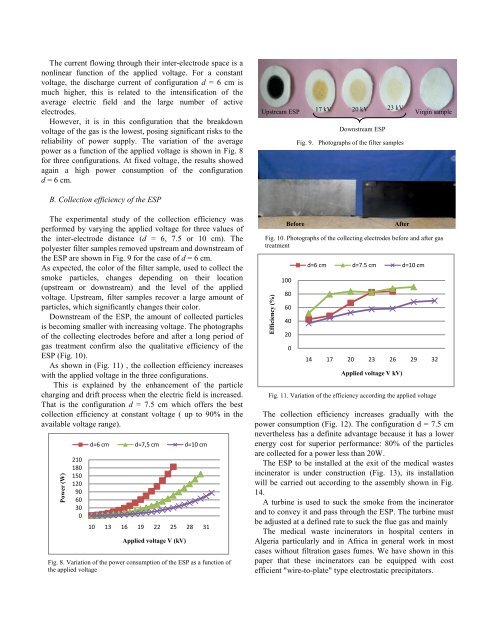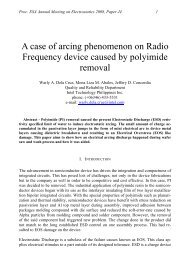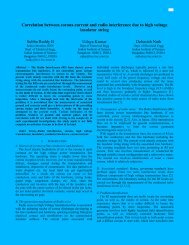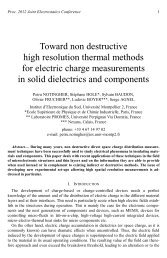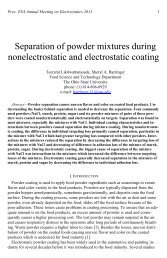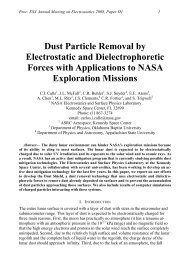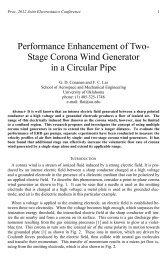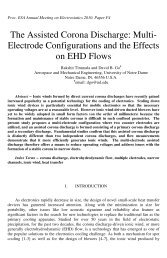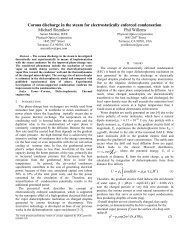Optimization of a Cost-Effective âWire-Plateâ Type ESP for ...
Optimization of a Cost-Effective âWire-Plateâ Type ESP for ...
Optimization of a Cost-Effective âWire-Plateâ Type ESP for ...
Create successful ePaper yourself
Turn your PDF publications into a flip-book with our unique Google optimized e-Paper software.
Power (W)<br />
Efficiency (%)<br />
The current flowing through their inter-electrode space is a<br />
nonlinear function <strong>of</strong> the applied voltage. For a constant<br />
voltage, the discharge current <strong>of</strong> configuration d = 6 cm is<br />
much higher, this is related to the intensification <strong>of</strong> the<br />
average electric field and the large number <strong>of</strong> active<br />
electrodes.<br />
However, it is in this configuration that the breakdown<br />
voltage <strong>of</strong> the gas is the lowest, posing significant risks to the<br />
reliability <strong>of</strong> power supply. The variation <strong>of</strong> the average<br />
power as a function <strong>of</strong> the applied voltage is shown in Fig. 8<br />
<strong>for</strong> three configurations. At fixed voltage, the results showed<br />
again a high power consumption <strong>of</strong> the configuration<br />
d = 6 cm.<br />
B. Collection efficiency <strong>of</strong> the <strong>ESP</strong><br />
Upstream <strong>ESP</strong> 17 kV 20 kV 23 kV<br />
Downstream <strong>ESP</strong><br />
Fig. 9. Photographs <strong>of</strong> the filter samples<br />
Virgin sample<br />
The experimental study <strong>of</strong> the collection efficiency was<br />
per<strong>for</strong>med by varying the applied voltage <strong>for</strong> three values <strong>of</strong><br />
the inter-electrode distance (d = 6, 7.5 or 10 cm). The<br />
polyester filter samples removed upstream and downstream <strong>of</strong><br />
the <strong>ESP</strong> are shown in Fig. 9 <strong>for</strong> the case <strong>of</strong> d = 6 cm.<br />
As expected, the color <strong>of</strong> the filter sample, used to collect the<br />
smoke particles, changes depending on their location<br />
(upstream or downstream) and the level <strong>of</strong> the applied<br />
voltage. Upstream, filter samples recover a large amount <strong>of</strong><br />
particles, which significantly changes their color.<br />
Downstream <strong>of</strong> the <strong>ESP</strong>, the amount <strong>of</strong> collected particles<br />
is becoming smaller with increasing voltage. The photographs<br />
<strong>of</strong> the collecting electrodes be<strong>for</strong>e and after a long period <strong>of</strong><br />
gas treatment confirm also the qualitative efficiency <strong>of</strong> the<br />
<strong>ESP</strong> (Fig. 10).<br />
As shown in (Fig. 11) , the collection efficiency increases<br />
with the applied voltage in the three configurations.<br />
This is explained by the enhancement <strong>of</strong> the particle<br />
charging and drift process when the electric field is increased.<br />
That is the configuration d = 7.5 cm which <strong>of</strong>fers the best<br />
collection efficiency at constant voltage ( up to 90% in the<br />
available voltage range).<br />
210<br />
180<br />
150<br />
120<br />
90<br />
60<br />
30<br />
0<br />
d=6 cm d=7,5 cm d=10 cm<br />
10 13 16 19 22 25 28 31<br />
Applied voltage V (kV)<br />
Fig. 8. Variation <strong>of</strong> the power consumption <strong>of</strong> the <strong>ESP</strong> as a function <strong>of</strong><br />
the applied voltage<br />
Be<strong>for</strong>e<br />
100<br />
80<br />
60<br />
40<br />
20<br />
0<br />
After<br />
Fig. 10. Photographs <strong>of</strong> the collecting electrodes be<strong>for</strong>e and after gas<br />
treatment<br />
d=6 cm d=7.5 cm d=10 cm<br />
14 17 20 23 26 29 32<br />
Applied voltage V kV)<br />
Fig. 11. Variation <strong>of</strong> the efficiency according the applied voltage<br />
The collection efficiency increases gradually with the<br />
power consumption (Fig. 12). The configuration d = 7.5 cm<br />
nevertheless has a definite advantage because it has a lower<br />
energy cost <strong>for</strong> superior per<strong>for</strong>mance: 80% <strong>of</strong> the particles<br />
are collected <strong>for</strong> a power less than 20W.<br />
The <strong>ESP</strong> to be installed at the exit <strong>of</strong> the medical wastes<br />
incinerator is under construction (Fig. 13), its installation<br />
will be carried out according to the assembly shown in Fig.<br />
14.<br />
A turbine is used to suck the smoke from the incinerator<br />
and to convey it and pass through the <strong>ESP</strong>. The turbine must<br />
be adjusted at a defined rate to suck the flue gas and mainly<br />
The medical waste incinerators in hospital centers in<br />
Algeria particularly and in Africa in general work in most<br />
cases without filtration gases fumes. We have shown in this<br />
paper that these incinerators can be equipped with cost<br />
efficient "wire-to-plate" type electrostatic precipitators.


